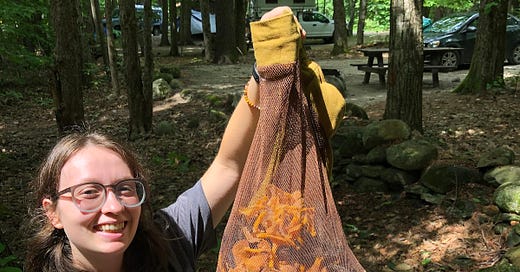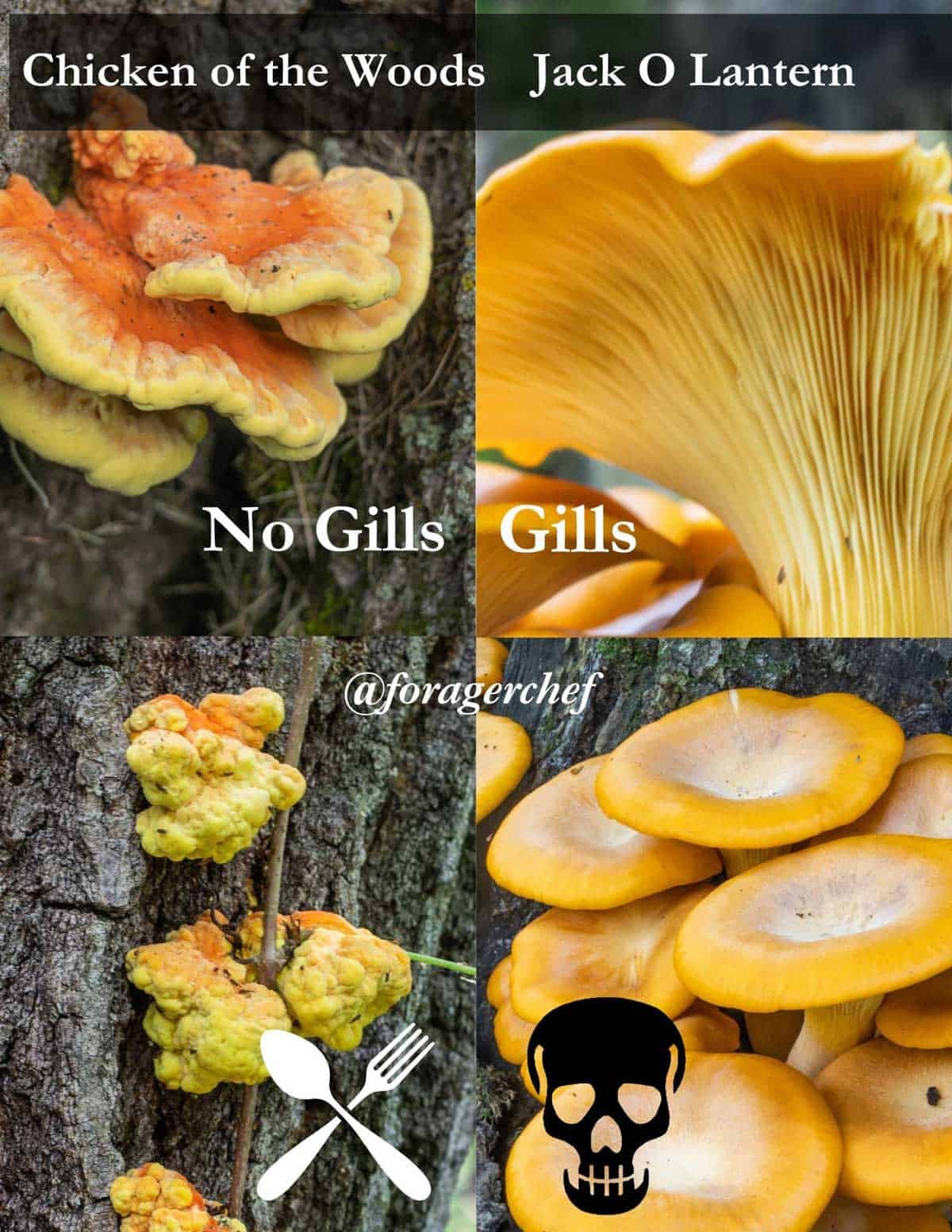Colombia certainly has its traditional foods and cuisines to treasure—from salchipapas and almojábanas to arepas and empanadas on every corner, delicious soups from every region, and traditional dishes like the bandeja paisa. Nonetheless, we may often find ourselves craving comfort foods from home. One of my top-tier comfort foods is a freshly foraged mushroom!
Thankfully, Colombia offers one of the most biodiverse ecosystems in the world, leading to unique fruits and plentiful produce. One area in which I have yet to see many Colombians fully tap into is the world of fungi. One friend in my town called one of my most beloved mushrooms “el regalo del diablo” when in reality, it is much more of “un regalo de Dios”.
Sharing mushroom foraging with locals here at my site has allowed others to enjoy eating mushrooms and recognize them as food.
Identifying Mushrooms
There are two categories in which we identify mushrooms: agaric and non-agaric. Agaric mushrooms generally have a stalk, cap, and gilled structure, whereas non-agaric mushrooms do not. Their structure is variable.
How to identify an agaric mushroom:
Identify the cap color.
Identify the cap size.
Identify the stalk color.
Identify the stalk size.
Identify the gill color.
Identify the gill attachment (attached, free, or recurrent).
Note smells, growth patterns, shape, texture, where you find the mushroom, and when you find the mushroom (season).
Non-agaric mushrooms do not have a stalk, cap, or gills. Instead, they have other identifying features. These species include: tooth fungi, boletes, polypore mushrooms, shelf and crust fungi, coral and club fungi, jelly and miscellaneous fungi, cup fungi, morels, false morels, saddles, stinkhorns, puffballs, earthballs, earthstars, and bird’s nest fungi. Within these species, there are some edible mushrooms (McKnight et al. 16-21).
Chicken of the Woods
“El regalo de Dios” in question, which is one of the most common mushrooms popping up in the Boyacá region right now, is called “chicken of the woods”, the Latin name being Laetiporus sulphureus. This mushroom naturally occurs on oak trees, especially fallen or dead ones. It can appear on other hardwoods as well. In the Andean region of Colombia, there are countless eucalyptus trees, where chicken of the woods can also be found.
The identifying features of this mushroom include:
Category: Non-agaric
Species: Shelf
Color: Yellow to orangish
Shape: Fan-shaped to almost semicircular. The top has a wavy appearance.
Size: 5–30 centimeters
Texture: Smooth or wrinkly, somewhat velvety
Growth Pattern: clumped together
Season: In the U.S., fall and sometimes spring. In Colombia—so far, spring.


Some Beginner Forager Tips from a Beginner Forager
Never eat a mushroom if you are not 100% sure of what it is.
Always know your deadly/poisonous look-alike. Do your research on the mushrooms you must avoid. When foraging for an edible mushroom, always know what poisonous look-alikes may exist. There are mushroom identification books, countless resources on YouTube, articles and blog pages, and Reddit communities dedicated to this.
Touching a mushroom won’t hurt you—only eating it will!
Sample a new wild mushroom before you indulge. Although there are plentiful, delicious mushrooms, some people may still have reactions to these edible mushrooms, not unlike any other food. Therefore, start with a small piece and wait a day to ensure you have no adverse side effects from the mushroom.
Always cook your foraged mushrooms! You can eat some store-bought mushrooms raw, but cooking will help with digestion and is overall safer with wild mushrooms.
Don’t forage mushrooms that are right next to a busy road. Mushrooms can absorb pollutants, and there are far too many of those in our environment.
Take only what you need. This will help to ensure future growth and spore dispersal. Mushrooms are also food for more than just us!
Spread the spores! As you shake, or even just move around, mushrooms will release their spores, which will, in turn, continue mushroom growth. This is great, and we want to help contribute to this growth. If you can use a mesh bag or woven basket to forage, then spores will naturally be able to fall out as you carry your foraged mushrooms.
Clean your wild mushrooms! Mushrooms can often be covered with dirt or bugs, as they are coming from the ground. Cut out any bad parts and brush off all dirt. You can wash them in water if you prefer. If you do this, make sure you allow them to properly dry.
Store your mushrooms in an open bag or container in the fridge with a damp cloth or paper towel. This allows the mushrooms to stay fresh.
Cooking your mushrooms
Now that you’ve found your mushroom, what can you do with it? One of the easiest and tastiest things you can do with a wild mushroom is sauté it in butter with some salt. Remember that if you do this, some mushrooms contain a lot of water and should be sautéed without butter first before you add them in.
If you’re feeling more adventurous and want to chef it up, there are countless recipes in which you can enjoy mushrooms. Below is one of my favorite recipes for Chicken of the Woods:
Recipe: Fried Chicken
Ingredients:
Oil for frying
Flour, about 1 cup (0.24 L)
2 Eggs
Seasonings, your choice, but I use garlic powder, onion powder, paprika, salt, and pepper
Chicken of the Woods, as much as your heart desires
Chosen sauces, I like to make honey mustard or a spicy mayo
Instructions:
Make sure your chicken of the woods is cleaned and prepped. Cut off any hard pieces. Cut the chicken into the desired size.
Set up a bowl for flour and the eggs.
Season your flour with the desired seasonings.
Toss the mushrooms first in flour, then in egg, then in flour again.
Heat a pot with the oil until it reaches about 315°F (157°C).
Add the breaded chicken of the woods into the oil until golden brown.
Remove, sprinkle with salt, and enjoy!
Here’s a great website to learn more about mushroom recipes: https://foragerchef.com.
If you decide to venture into the wonderful world of fungi, be ready to learn a lot and always proceed with caution. There are so many interesting, beautiful, and delicious mushrooms out there for you to explore if you are willing. Happy foraging!
Reference
McKnight, K. B., McKnight, K. B., Rohrer, J. R., Ward, K. M., & McKnight, K. H. (2021). Peterson Field Guide to Mushrooms of North America. Houghton Mifflin Harcourt.
Disclaimer: The content of this publication is generated by individual volunteers. The opinions and thoughts expressed here do not reflect any position of the United States government or the Peace Corps.








Love this! Reminds me of the foraged chicken of the woods mushroom and ramp/allium recipe I made inspired from my Appalachian Trail thru hike. check it out:
https://thesecretingredient.substack.com/p/what-my-great-grandfathers-memoir